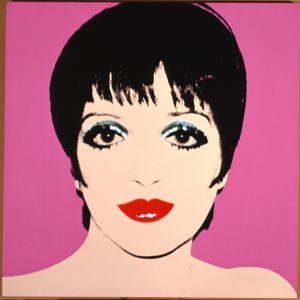Andy Warhol wasn’t a photographer in the normal sense, yet photography was at the core of his art. An impressive new exhibition at Stanford University shows how his obsession with taking pictures provided the raw material for finished works such as his iconic silkscreen paintings of the hip and the famous, from Liza Minnelli to Chairman Mao.
In 2014, the university acquired virtually all of Warhol’s black-and-white photography made from 1976 to his death in 1987, both contact sheets and the corresponding negatives, from the Andy Warhol Foundation for the Visual Arts in Pittsburgh. Since then, Stanford researchers have digitized the lot – some 3,600 rolls of film, or about 130,000 images – and organized the current exhibition, “Contact Warhol: Photography Without End.”
The show includes a healthy selection of the contact sheets themselves, many marked up with red grease pencil, along with larger prints of single and multiple frames. There are also color Polaroid snapshots, large black-and-white prints of some individual images, collages of multiple prints, and several of the famous color silkscreens. Curated by Stanford professors Richard Meyer and Peggy Phelan, the clear and understated installation in a single large gallery lets the works do the talking.
Taken together, the photographs constitute a portrait of a hard-working artist whose subject matter was both his own life and the celebrity world that he documented like an anthropologist. He took pictures of his studio staff, his gay friends, his fellow artists like Keith Haring and Jean-Michel Basquiat, and his nightlife pals like Liza and Halston, Bianca Jagger, and John Lennon.
“I have Social Disease. I have to go out every night,” Warhol reportedly once said. “If I stay home one night, I start spreading rumors to my dogs.”
Warhol’s nightlife in the 1970s wasn’t just for fun, though. He was trolling for both images and potential clients for his work, Meyer said at a recent curator’s talk about the exhibition. “If you had $35,000, you could have Andy Warhol paint your portrait and make you look like a star.”
![Detail from Contact Sheet [Andy Warhol, Bianca Jagger, Halston, Diane de Beauvau, Bethann Hardison in the back of a limousine], 1976](https://www.culturalweekly.com/wp-content/uploads/2018/10/Limo_detail-e1541007685963.jpg)
A contact sheet from 1976 gives a flavor of Warhol’s cruising, with a series of horizontal shots taken from the back seat of a limo and featuring Halston, Bianca Jagger, the French aristocrat and socialite Diane de Beauvau, and the fashion model Bethann Hardison. One frame includes Warhol himself, looking dapper in a dark jacket, white shirt, and striped tie.
Warhol was “a paradoxical combination of high and low,” with “longstanding relations to camp and queer culture,” to gay men and female divas, Meyer said. He also “paved the way for artists to become much more open about money and fame.”
Yet Warhol was also an obsessive craftsman. The exhibition shows how he picked this particular image rather than a dozen (or three dozen) others as the basis for a finished work. In one case, the large 1976 silkscreen painting “Hammer and Sickle” is displayed on a wall covered with enlarged contact sheet images, almost like wallpaper, dozens and dozens of photos of the hammer and sickle in question. He moves the props this way and that, tries this camera angle and then another, over and over. Then in the final work he colors over the black-and-white photo so much that the original image almost disappears.
![Andy Warhol, Bruno Bischofberger, Detail from Contact Sheet [Jean-Michel Basquiat photo shoot for Polaroid portrait], 1982.](https://www.culturalweekly.com/wp-content/uploads/2018/10/Basquiat_detail-e1541007754505.jpg)
The pictures are displayed in a series of general themes, from Warhol’s early obsession with street signage – recalling the work of the great Walker Evans – to gay and celebrity culture. There are clusters of images from photo shoots of famous people (Basquiat, Haring, Liza, Debbie Harry, Dolly Parton), a series from Warhol’s trip to China, a corner devoted to Warhol in drag (with lipstick and much nicer hair than his usual mop), even a section of contact sheets of gay boys engaged in sex at the Factory. (In compensation, perhaps, there’s also a wall of stark-naked portraits of the young and pretty Pat Hearn, who later became a prominent art dealer in Manhattan.)

Warhol never considered his photography to be art, just part of a working method that led to the real thing, his still powerful silkscreen paintings. While other Pop artists like Roy Lichtenstein or Ed Ruscha appropriated comic books or gas stations as their source material, Warhol could transform a simple Polaroid snapshot into a more abstract, intense, and enduring silkscreen portrait.
Liza Minnelli – with short black hair, amped-up blue eyeliner, widely spaced brown eyes, intensely red lips turned up in an enigmatic smile – stares straight at us in her 1979 portrait. Smoothed and abstracted from the original Polaroid, she’s a Mona Lisa for the Disco Age.
“Contact Warhol: Photography Without End” runs through Jan. 6 at the Cantor Arts Center, Stanford University, Stanford, California. An extensive catalog is co-published by the Cantor Arts Center and MIT Press.
All photos are a gift of, and copyright by, the Andy Warhol Foundation for the Visual Arts Inc.
The Warhol photo archive is available for viewing at stanford.io/2xYWJbn.
(Featured image: Andy Warhol, Detail from Contact Sheet [Photo shoot with Andy Warhol with shadow], 1986.)
